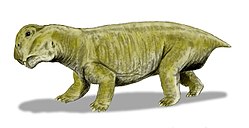| Dinanomodon | |
|---|---|
 | |
| Skull of Dinanomodon gilli (SAM-PK-K10220) on display in the Iziko South African Museum | |
| Scientific classification | |
| Kingdom: | Animalia |
| Phylum: | Chordata |
| Clade: | Synapsida |
| Clade: | Therapsida |
| Clade: | † Anomodontia |
| Clade: | † Dicynodontia |
| Infraorder: | † Dicynodontoidea |
| Genus: | † Dinanomodon Broom 1938 |
| Type species | |
| †Dinanomodon rubidgei Broom, 1938 (Junior synonym of D. gilli) | |
| Species | |
| |
| Synonyms [1] | |
Synonyms of D. gilli
| |
Dinanomodon is a genus of dicynodont that lived during the Late Permian (Lopingian) of the South Africa and China. Two species are recognised, D. gilli from the Cistecephalus and Daptocephalus Assemblage Zones of the Balfour Formation, Beaufort Group, in the Karoo Basin of South Africa, and D. guoi from the Gansu Province of China. [2] [3] [4] [5]





